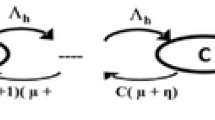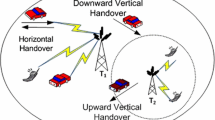Abstract
A mathematical model for analytical study on complete and partial channel allocation schemes is presented in this paper. Expression for the queue length distribution has been analytically derived. The mathematical model can be used for analysis of multiple call categories like new calls, handoff calls, delay tolerant or delay sensitive calls. This adaptive mathematical model can be utilized to design optimal channel allocation algorithms, or even test the already established resource allocation schemes for provisioning of Quality-of-Service to enable the usage of real time mobile applications. Most existing studies depend upon simulation experiments to investigate the performance of their proposed algorithms, but the mathematical model presented here can really help to evaluate such proposals from an analytical perspective.
Similar content being viewed by others
References
Tripathi, J. N. D., Jeffery, N., & Van Landingham, H. F. (1998). Handoff in cellular systems. IEEE Personal Communications, 5(6), 26–37.
Ekiz, C. N. et al. (2005). An overview of handoff techniques in cellular networks. International Journal of Information Technology, 2(3), 132–136.
Leu, A. E., & Mark, B. L. (2002). Modeling and analysis of fast handoff algorithms for microcellular networks. Proceedings of the 10th IEEE MASCOTS’2002 (pp. 321–328), October 2002.
Sheu, T. L., & Yang, W. C. (2005). Pre-emptive channel allocation model for heterogeneous cellular networks. IEE Proceedings, 152(1), 53–60.
Xu, Z., Ye, Z., Krishnamurthy, S. V., Tripathi, S. K., & Molle, M. A new adaptive channel reservation scheme for handoff calls in wireless cellular networks. In Lecture notes in computer science. Berlin: Springer.
Ekici, E., & Ersoy, C. (2001). Multi-tier network dimensioning. Wireless Networks, 7, 401–411.
Chang, C., Chang, C. H., & Lo, K. R. (1999). Analysis of a hierarchical cellular system with reneging and dropping for waiting new and handoff calls. IEEE Transactions on Vehicular Technology, 48(4).
Oliver, M., & Borras, J. (1999). Performance evaluation of variable reservation policies for hand-off prioritization in mobile networks. In Infocom ’99 proceedings of IEEE (Vol. 3, pp. 1187–1194).
Tekinay, S., & Jabbari, B. (1992). A measurement-based prioritization scheme for handovers in mobile cellular networks. IEEE Journal on Selected Areas in Communications, 10(8).
Hac, A., & Armstrong, A. (2001). Resource allocation scheme for QoS provisioning in microcellular networks carrying multimedia traffic. International Journal of Network Management, 11(5), 277–307.
Thing, I. L.-J., & Luo, X. Y. (2004). A robust M/M/1/K scheme for providing handoff dropping QoS in multi-service mobile networks. Wireless Networks, 301–309.
Kamra, A., Bansal, M., Hlavacs, H., & Haring, G. (2002). Modelling resource management for multi-class traffic in mobile cellular networks. In Proceedings of the 35th Hawaii international conference on system sciences (pp. 1531–1548).
Tekinay, S., & Jabbari, B. (1992). A measurement-based prioritization scheme for handovers in mobile cellular networks. IEEE Journal on Selected Areas in Communications, 10(8), 1343–1350.
Katz, R. H. (1996). Adaptation and mobility in wireless information systems. IEEE Personal Communication Magazine, 1(1).
Tripathi, N. D., Reed, J. H., & Vanlandingham., H. F. (1998). Handoff in cellular systems. IEEE Personal Communication Magazine.
Wang, H. J., Katz, R. H., & Giese, J. (1999). Policy-enabled handoffs across heterogeneous wireless networks. In WMCSA 99, New Orleans, LA.
Kim, Y. C., Lee, D. E., Lee, B. J., Kim, Y. S., & Mukherjee, B. (1999). Dynamic channel reservation based on mobility in wireless ATM networks. IEEE Communication Magazine, 37(1), 47–51.
Yu, O. T., & Leung, V. C. M. (1997). Adaptive resource allocation for prioritized call admission over an ATM-based wireless PCN. IEEE Journal on Selected Areas in Communications, 15(7), 1208–1225.
Chiu, M., & Bassiouni, M. (2000). Predictive schemes for handoff prioritization in cellular networks based on mobile positioning. IEEE Journal on Selected Areas in Communications, 18(3), 510–522.
Zhuang, W., Chua, K., & Jiang, S. (1998). Measurement-based dynamic bandwidth reservation scheme for handoff in mobile multimedia networks. In Proceedings of the IEEE international conference on universal personal communications.
Bharghavan, V., & Mysore, J. (1997). Profile based next-cell prediction in indoor wireless LANs. In Proceedings of the IEEE Singapore international conference on networks.
Levine, D., Akyildiz, I., & Naghshineh, M. (1997). A resource estimation and call admission algorithm for wireless multimedia networks using the shadow cluster concept. IEEE/ACM Transactions on Networking, 5(1), 1–12.
Bharghavan, V., & Mysore, J. (1997). Profile based next-cell prediction in indoor wireless LANs. In Proceedings of the IEEE Singapore international conference on networks.
Fang, Y., & Chlamtac., I. (1999). A new mobility model and its application in channel holding time characterization in PCS networks. In INFOCOM ’99.
Zander, J., & Eriksson, H. (1993). Asymptotic bounds on the performance of a class of dynamic channel assignment algorithms. IEEE Journal on Selected Areas in Communications, 11(6), 926–932.
Schwartz, M. (1995). Network management and control issues in multimedia wireless networks. IEEE Personal Communications, 2, 8–16.
Eom, D. S., Sugano, M., Murata, M., & Miyahara, H. (1999). Call admission control for QoS provisioning in multimedia wireless ATM networks. IEICE Transactions on Communications, E82-B(1), 14–23.
Tekinay, S. (1994). Modeling and analysis of cellular networks with highly mobile heterogeneous traffic sources. PhD thesis. George Mason University.
Naghshineh, M., & Schwartz, M. (1996). Distributed call admission control in mobile/wireless networks. IEEE Journal on Selected Areas in Communications.
Sutivong, A., & Peha, J. (1997). Call admission control algorithms for cellular systems: proposal and comparison. In Globecom.
Tang, S., & Li, W. (2007). Performance analysis of a channel allocation scheme for multi-service mobile cellular networks: research articles. International Journal on Communication Systems, 20(2), 177–205.
Chao, B., & Chen, W. (1997). Connection admission control for mobile multiple class personal communications networks. IEEE Journal on Selected Areas in Communications, 15(8), 1618–1626.
Misic, J., Chanson, S., & Lai, F. (1997). Admission control for wireless networks with heterogeneous traffic using event based resource estimation. In IEEE ICCCN 97, September 1997.
Oliveira, C., Kim, J., & Suda, T. (1996). Quality-of-service guarantees in high-speed multimedia wireless networks. In IEEE ICC ’96.
Wang, Y. T., & Sheu, J. P. (2006). Adaptive channel borrowing for quality of service in wireless cellular networks. International Journal on Communication Systems, 19(2), 205–224.
Lin, P., & Lin, Y.-B. (2001). Channel allocation for GPRS. IEEE Transactions on Vehicular Technology, 50(2), 375–384.
Sleptchenko, A. Multi-class, multi-server queues with non-preemptive priorities (Technical Report 2003-016). EURANDOM, Eindhoven University of Technology.
Jouini, O., & Dallery., Y. (2007, submitted). Analysis of a multiple priority queue with impatient customers. Operation Research.
Fang, Y., & Zhang, Y. (2002). Call admission control schemes and performance analysis in wireless mobile networks. IEEE Transactions on Vehicular Technology, 51(2), 371–382.
Salih, T., & Fidanboylu, K. M. (2003). Performance analysis and modeling of two-tier cellular networks with queuing handoff calls. In Eighth IEEE international symposium on computers and communications (ISCC’2003) (Vol. 1, pp. 143–148), Turkey.
Hong, D., & Rappaport, S. S. (1986). Traffic model and performance analysis for cellular mobile radio telephone systems with prioritized and nonprioritized handoff procedures. IEEE Transactions on Vehicular Technology, VT-35, 77–92.
Ghazal, S., Mokdad, L., & Ben-Othman, J. (2008). Performance analysis of UGS, rtPS, nrtPS admission control in WiMAX networks. In Proceedings of the IEEE international conference on communications (ICC 2008).
Min, G., & Jin, X. (2008). Performance modelling of random early detection based congestion control for multi-class self-similar network traffic. In Proceedings of the IEEE international conference on communications (ICC’2008), Beijing, China, 19–23 May 2008.
Pathak, A., Mangalam Srivatsa, A., & Xie, J. (2008). An analytical model for handoff overhead analysis in internet-based infrastructure mesh networks. In Proceedings of the IEEE international conference on communications (ICC 2008) (pp. 2884–2888), May 2008.
Author information
Authors and Affiliations
Corresponding author
Rights and permissions
About this article
Cite this article
Baloch, R.A., Awan, I. & Min, G. A mathematical model for wireless channel allocation and handoff schemes. Telecommun Syst 45, 275–287 (2010). https://doi.org/10.1007/s11235-009-9267-5
Published:
Issue Date:
DOI: https://doi.org/10.1007/s11235-009-9267-5




